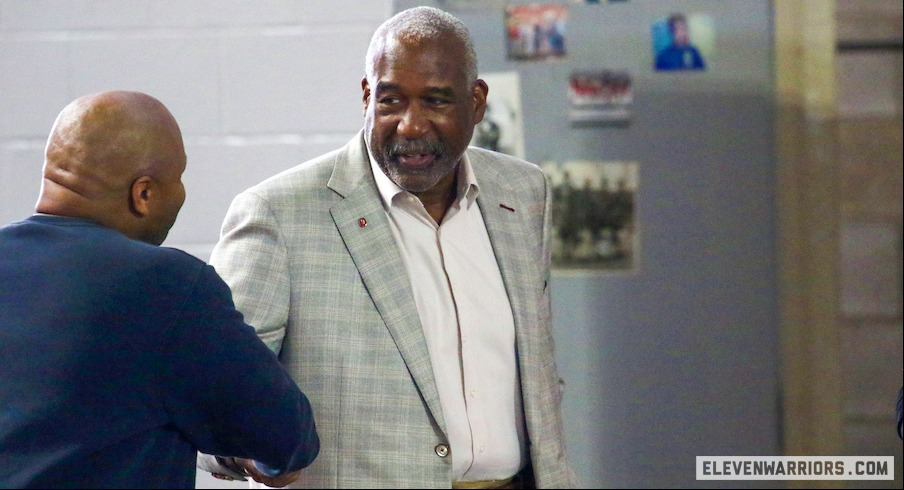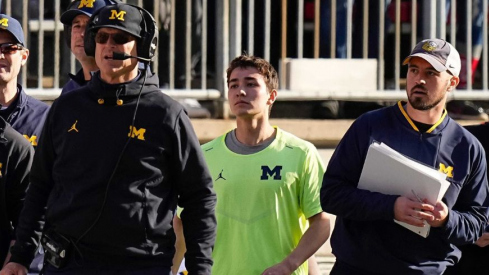For most of 2022, Ohio State’s concern about its standing in the NIL arms race was apparent.
During a panel discussion at an event with local business leaders last June, Ryan Day said Ohio State would need $13 million in NIL money to keep the football team’s roster together. When asked about that number on signing day in December, following an end to the 2023 recruiting cycle in which NIL was a factor in the Buckeyes missing out on several high-profile targets, Day said Ohio State was still working toward that number and that the Buckeyes would “need all the help we can get.”
By this spring, however, Day was singing a more optimistic tune.
“It's a critical part of our recruiting. And we've had a lot of people who have embraced it. And because of that, we're starting to build some momentum here in recruiting,” Day said in April. “I also think that we're in a better place to compete for some of the bigger guys in the country.”
Ohio State athletic director Gene Smith echoed Day’s optimism when he was asked how he feels about the state of the Buckeyes’ current NIL efforts during his interview with Eleven Warriors on Real Pod Wednesdays last week. Nearly two years after the NCAA first permitted college athletes to make money off of their names, images and likenesses, Smith believes Ohio State has adapted as needed after initially taking a cautious approach to an uncertain landscape.
“Change management is something that over my years that I’ve really embraced in a great way. Change is always in front of us. So how we respond to change is critical. And I think at the beginning, no one actually knew exactly what we were going to be dealing with,” Smith said. “We knew what we wanted to happen. We knew that it was a good thing for NIL to be in place. But how do you make it happen and what emerges? And the fact that we, as an association, provided an opportunity for our student-athletes through NIL, but we also entered into it, advisors/agents. And no one could project their involvement in this process.
“And so I think over time, we've learned that. Collectives emerged, and they've learned more about themselves and how they want to operate. And I think we're much better now and feel much better about it because we went through that learning curve, that change management part. And sometimes in life, you have to move slow to move fast. And I was trying to help our team be patient. Sometimes with change, you just have to be patient. And you might take some hits, you might take some lumps, but you have to be patient when you don't have everything tied down. And so now that we have clarity and those types of things on how we can operate, we feel really good about where we are.”
Ohio State now has three NIL collectives working on its behalf – The Foundation, Cohesion Foundation and The 1870 Society – to help line up deals for both its current and future athletes. While OSU initially discouraged its collectives from communicating with recruits due to a lack of clarity surrounding NCAA rules, that stance has changed as NIL collectives have continued to play a major role in recruiting around the country without any NCAA repercussions.
“Sometimes with change, you just have to be patient ... now that we have clarity and those types of things on how we can operate, we feel really good about where we are.”– Gene Smith on how Ohio State has adapted to NIL
That said, Smith still believes stronger regulations are needed to govern NIL in college sports. Specifically, Smith wants to see Congress pass federal legislation to govern NIL, as the differences in NIL laws currently in effect across various states make it difficult for the NCAA to regulate NIL while abiding by all of those laws.
“It's still the wild, wild west because there's factors that we don't control,” Smith said. “Because we don't have federal standards and because the NCAA is limited in what they can do from an enforcement point of view, we have all types of things happening.”
Smith recently endorsed the Student Athlete Level Playing Field Act, a bipartisan bill introduced in the House of Representatives by Mike Carey and Greg Landsman, both from Ohio, to create a federal standard for NIL in college sports. Numerous other bills proposing federal legislation for NIL have also been proposed in both chambers of Congress. But none of those bills have actually made it to a vote.
Nevertheless, Smith remains optimistic that there will eventually be a national NIL law even though it remains far from imminent right now.
“I'm hopeful that over the next couple of years – if not this year, over the next couple of years – we get something federally,” Smith said. “I think we need something. This summer might be challenging. It might be challenging for that to happen. But the fact that it's been positioned by (Rep.) Carey puts it in a great position to be considered. So I'm glad it's there. And we'll see how it rolls.”
The model of many NIL collectives could face a challenge at the federal level from the IRS, which published a memo late last week stating that donations to NIL collectives should not be considered tax-exempt. Two of Ohio State’s three NIL collectives, The Foundation and Cohesion Foundation, are registered as 501(c)(3) nonprofits and offer tax-exempt donations; The 1870 Society, Ohio State’s newest collective, is a for-profit entity.
We've structured our collective to put ourselves in the best position to serve the student-athletes, the university, and the Ohio State fanbase long into the future.
— The 1870 Society (@the1870society) June 14, 2023
Here's what that means: pic.twitter.com/YZY4fdzEnW
The uncertainty of how federal and state laws could continue to change college sports extends beyond just NIL. The NCAA’s entire amateurism model is currently facing multiple legal challenges including Johnson v. NCAA, a lawsuit being heard by the U.S. 3rd Circuit Court of Appeals that asserts college athletes should be classified as employees, and the College Athlete Protection Act, a bill that would require colleges in California to share revenues with athletes from revenue-generating teams.
Smith doesn’t know exactly what the future of college sports will look like. But he says he and his fellow athletic directors around the Big Ten are having conversations about how they might need to adapt for potential changes to the college sports model that could happen. Smith said they aren’t allowed to have those conversations between conferences due to the Supreme Court’s 2021 ruling on NCAA v. Alston, which prohibits conferences from working together to limit athlete compensation, but that Ohio State and the Big Ten are working to be as prepared as they can be.
“We have an internal group that's having conversations in the Big Ten. I want to say, we've had maybe four conversations as ADs and formal meetings where we've talked about different models,” Smith said. “The model will change. I wish I had a crystal ball. But we're doing our best to be ready for it.”
As things currently stand, NCAA rules still prohibit schools from directly paying athletes, but the lack of national NIL regulations leaves plenty of leeway for schools to work with collectives to help their athletes make money. Until those rules change, Ohio State will seek to do as much as it is allowed to do to use NIL to its advantage.
“It's hard to predict what's going to happen on the Hill. It really is. And so what we've been focused more is on our structure, our program, working closely with our collectives, who's doing a marvelous job, and trying to make sure we do things locally the right way,” Smith said.


